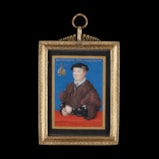FLEMISH SCHOOL (16th century)
Portrait of a gentleman, called Leonhardus Baur (b.1529), aged twenty, resting on a table covered with red cloth, wearing a black doublet, sleeves slashed to reveal white, and a brown coat, sleeves slashed to reveal maroon, white shirt tied with black ribbon, and a black cap with gold and silver pins; a merchant’s symbol and memento mori to the top left
16th century
Watercolour on parchment, laid on card
Inscribed and dated, LEONHARDVS BaVR .:. Aetatis Suæ, XX/1549 (top)
Gilded-metal Seamer frame with spiral cresting, the reverse engraved with cipher for James Sotheby
Rectangular, 69 x 51 mm (2 ³/₄ x 2 inches)
SOLD
Between being sold in 1955 and 2005, an attribution to Bernard Lens was added, assuming that later additions had been commissioned from the artist by Sotheby. Lens was known for his copies of old masters, however there is nothing within Sotheby’s notebook to suggest that he was commissioned to work on this particular piece. However, the fact that the calligraphic inscription appears less definitive in an image of the miniature in Williamson’s 1926 publication The Miniature Collector, suggest that this has been strengthened.
Leonhardus Baur (Burr or Bur) was most likely a merchant, signified by the merchant’s mark in the top left hand side of the composition.[3] It is known that at this time merchants and members of the middle class were commissioning portrait miniatures and as they could not use heraldry or coats of arms within these images, merchant marks were used to identify themselves. Furthermore, the simple style of cap that he wears is typical of the fashion of the professional classes of the time, as can also be recognised in Holbein’s group of portraits of steelyard workers from the mid-sixteenth century. Holbein’s portraits of the Hanseatic League (a powerful German trading organisation) are an inspiration for the sitter’s pose and composition, as these showed the seated members against an unadorned background, with their age noted.[4] Although the sitter here is yet to be identified, a printer called Daniel Baur lived in Innsbruck in 1603 who was possibly a descendent.
[1] Christie’s, London, 11th October 1955, lot 52.
[2] V&A accession number P.159-1910.
[3] Surrounded by a shroud, and topped with a skull and sand timer, the merchant’s mark in this portrait is combined with a memento mori (Latin for ‘remember that you die.’) serving as a reminder of the transience of human life.
[4] Holbein was commissioned to decorate the meeting hall and to produce individual portraits of the guild members. This group has now been disbanded, one example can be seen at Yale University Art Gallery, dated 1538 (1977.187).
James Sotheby (1655-1720) and by descent;
The late Major-General Frederick Edward Sotheby; Sotheby’s, London, 11 October 1955, lot 52 (£850 to Eisemann);
The late Eric Korner;
Christie’s, London, 7th December 2004, lot 124 (as Ascribed to Hans Holbein the Younger (Anglo-German, 1497/8-1543 and Bernard Lens (British, 1672-1740).
London, Burlington Fine Arts Club, Portrait Miniatures, 1889, p.61, no.2 (as portrait of Leonard Burr);
Manchester, City Art Gallery, Old and Modern Miniatures, 1926, no. 243 (as by Holbein).

shipping notice
Worldwide shipping is included in all prices.
The Limner Company does not accept any responsibility for import duty, this is to be paid by the buyer.
Some stock items contain materials from endangered species which are governed by CITES regulations and will require a permit to export outside of Great Britain. If a certificate of export is required then this will be the responsibility of and paid for by the buyer .
you may also like













